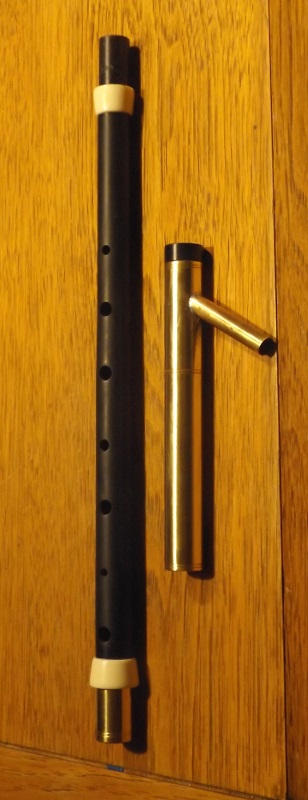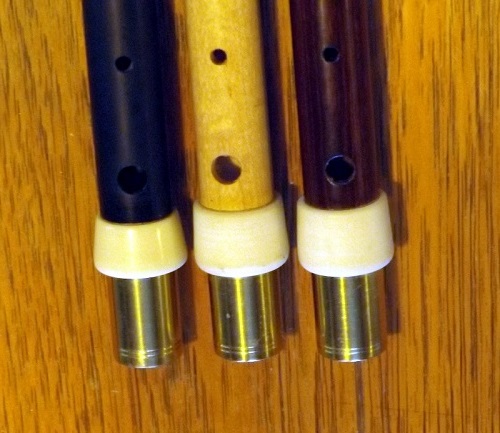The Daye "Classic"
Style
Traditional Uilleann Chanter
25 Sept. 2017
Copyright
2017 David C. Daye - all rights reserved
Questions email David Daye by: Clicking
Here

Background / History
This chanter is a wide bore Concert D chanter, traditionally reamed and turned, based on an older chanter in the Rowsome
family. The bore and tonehole data came via Craig Fischer from probes
he supplied to Kevin Rowsome who made the measurements a number of years
ago. The chanter is some 10 mm shorter than common modern instruments,
and probably played originally at an old higher pitch. I don't know how many were originally made but a few have been heard by the general public.
This year I came to realize that the chanter plays comfortably at modern pitch when fit with an oversized reed. My old educational web site hosts a diagram made by David Quinn many years ago, giving dimensions for a reed played by Liam O'Flynn. This completes the chanter-and-reed combination I'm preparing to offer.
The "Classic" Sound
This chanter and reed combination gives a tone I find reminiscent of the uilleann pipe sound that many of us in the world outside Irish traditional music first heard in the mid and late 20th century. For that reason I'm calling my version "classic." It also plays easily, in keeping with the performances we saw from the great players in that era, and it's tolerant of modest variation in reed or chanter.
Here is a short demonstration video of the last test version, including scales, tune phrases and common expressive sounds and ornamentations. It concludes with a few
excerpts of a recent live concert when I played as a guest artist with a large church choir and stage orchestra in December 2016. The demonstration chanter is faithfully scaled longer for playing a more common style reed at modern pitch, an approach I tested periodically for several years. The sound is the same but it isn't as cooperative to play or fit with reeds as the version I'm preparing to offer. The production model will have no intentional alterations of mine from the original design, other than a cylindrical sliding reed seat for tuning convenience.
This link will be updated as I make a more complete demonstration using the final model of chanter and reed.
Daye "Classic" traditional chanter demonstration video
Construction
 The chanter is traditionally reamed from a set of about 10
reamers specific to this instrument. There is no brass tubing bore like the
Penny-Chanter's, so it has the same light weight of any traditional chanter.
I am using a modern cylindrical reed seat so that the reed can quickly be moved in
and out for tuning. Most chanters will be made of black
Delrin plastic with an entirely traditional though simple appearance for
my budget market. The bottom of the chanter is brass clad while there are
traditionally turned decorative ferrules of a new high quality imitation
ivory in a simple shape.
The chanter is traditionally reamed from a set of about 10
reamers specific to this instrument. There is no brass tubing bore like the
Penny-Chanter's, so it has the same light weight of any traditional chanter.
I am using a modern cylindrical reed seat so that the reed can quickly be moved in
and out for tuning. Most chanters will be made of black
Delrin plastic with an entirely traditional though simple appearance for
my budget market. The bottom of the chanter is brass clad while there are
traditionally turned decorative ferrules of a new high quality imitation
ivory in a simple shape.
Availability is expected some time in October when I have had time to develop production aids for reeds and chanters. Price will be above Penny-Chanter, but still in a modest range due to simple presentation and artificial materials. Initially I discourage beginners from buying, until I gain experience supporting the instrument for more experienced players.
Click
here to go to David Daye's Pipe-Making Page.
To E-mail David Daye
click here
Telephone Cuyahoga Falls Ohio USA (New York City time zone) 330-923-DAYE
(3293)
Bottom of Traditional Uilleann Chanters Page
 The chanter is traditionally reamed from a set of about 10
reamers specific to this instrument. There is no brass tubing bore like the
Penny-Chanter's, so it has the same light weight of any traditional chanter.
I am using a modern cylindrical reed seat so that the reed can quickly be moved in
and out for tuning. Most chanters will be made of black
Delrin plastic with an entirely traditional though simple appearance for
my budget market. The bottom of the chanter is brass clad while there are
traditionally turned decorative ferrules of a new high quality imitation
ivory in a simple shape.
The chanter is traditionally reamed from a set of about 10
reamers specific to this instrument. There is no brass tubing bore like the
Penny-Chanter's, so it has the same light weight of any traditional chanter.
I am using a modern cylindrical reed seat so that the reed can quickly be moved in
and out for tuning. Most chanters will be made of black
Delrin plastic with an entirely traditional though simple appearance for
my budget market. The bottom of the chanter is brass clad while there are
traditionally turned decorative ferrules of a new high quality imitation
ivory in a simple shape.